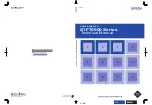
CHAPTER 4
PAGE 19
CHAPTER 4
TRANSMITTING WITH THE CWR6850
This section of the manual will discuss the transmitting feature of the CWR6850. Extensive use will
be made of transmitting using the Morse mode and the CWR6850's internal side-tone monitor to il-
lustrate various transmit actions. Unless otherwise noted, all actions demonstrated while in Morse
mode also apply to RTTY modes.
4.1
The Keyboard
The keyboard for the CWR6850 is a small separate unit, attached to the CWR6850 through a flexi-
ble cord. This keyboard can be placed on the operating table, or you may prefer to try the "easy
chair" approach, holding the keyboard in your lap.
Figure 3
The CWR6850 Keyboard
As shown in Figure 3, the keyboard has 55 keys, arranged similar to those of a standard typewriter
with "extra" control keys to the left and right of the alphanumeric group. Two, three or four differ-
ent characters may be typed by using the SHIFT, CTRL (control) or SHIFT with CTRL keys in con-
junction with the gray keys. The actual characters of functions generated with each combination
varies to some degree with the code selected (ASCII, BAUDOT or MORSE); details of these special
combinations will be explained more fully in later sections of this manual.
In general, use the keyboard as you would a typewriter, making use of the SHIFT key when re-
quired. For example, typing on just the "1" key will enter a number 1 for transmitting; SHIFT-"1"
would enter an exclamation point "!". As on a typewriter, hold the SHIFT down while striking the
second key. Similarly, when ASCII is used, striking "G" will enter a lower case "g", SHIFT-"G" an
upper case "G" and CTRL-"G" will transmit the code for the bell signal. The double combination
SHIFT- CTRL-"G" produces the same output as "CTRL-G" (bell). Note: upper and lower case letter
are only available in ASCII code when the LOCK U.O.S. / ON button is OUT; only upper case let-
ters are available in Baudot and CW.
The standard alphabet, numbers and punctuation symbols are all located on gray colored keytops;
the blue keys are for control or special uses. The BS (Back Space) allows you to edit any errors
you may have made while typing. Each operation of the BS key will back-up the keyboard cursor
one space, removing any characters previously occupying that position. Note that the function of
the BS key and the RUB OUT key is different. Use BS for editing; the RUB OUT key generates the
ASCII RUB OUT (DELETE) command. Use of the RUB OUT key is discussed in more detail in sec-
tion 4.3.
Содержание CWR6850
Страница 1: ...CWR6850 TELEREADER INSTRUCTION MANUAL QUALITY COMMUNICATIONS EQUIPMENT April 1982 Printing...
Страница 6: ...CHAPTER 2 PAGE 6...
Страница 35: ...CHAPTER 5 PAGE 35 Figure 4 Connections To The CWR6850...
Страница 41: ...CHAPTER 5 PAGE 41 Figure 6 Typical Video Detector Figure 7 Modified Video Detector...
Страница 60: ...APPENDIX B PAGE 60 APPENDIX B CWR6850 DISPLAY FORMAT TOTAL DISPLAY CAPABILITY...
Страница 61: ...APPENDIX B PAGE 61 PAGE 0 and PAGE 1 DISPLAY FORMAT...
Страница 62: ...APPENDIX B PAGE 62 PAGE 2 and PAGE 3 DISPLAY FORMAT...
















































